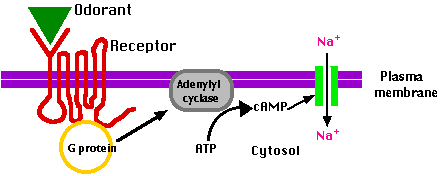The Sense of Smell
Smell depends on sensory receptors that respond to airborne chemicals. In humans, these chemoreceptors are located in the olfactory epithelium — a patch of tissue about the size of a postage stamp located high in the nasal cavity.
The olfactory epithelium is made up of three kinds of cells:
- sensory neurons each with a primary cilium
- supporting cells between them
- basal cells that divide regularly producing a fresh crop of sensory neurons to replace those that die (and providing an exception to the usual rule that neurons seldom are replaced).
The sequence of events

- The cilia of the sensory neurons are immersed in a layer of mucus. Odorant molecules (molecules that we can smell) dissolve in the mucus and
- bind to receptors on the cilia. These are "7-pass" transmembrane proteins.
- Binding of the odorant activates a G protein coupled to the receptor on its cytoplasmic side.
- This activates adenylyl cyclase, an enzyme embedded in the plasma membrane of the cilia.
- Adenylyl cyclase catalyzes the conversion of ATP to the "second messenger" cyclic AMP (cAMP) in the cytosol.
| Odorant receptors represent one family of many types of G-protein-coupled receptors (GPCRs). Some other examples of GPCRs:
|
- cAMP opens up ligand-gated sodium channels for the facilitated diffusion of Na+ into the cell
- The influx of Na+ reduces the potential across the plasma membrane.
- If this depolarization reaches threshold, it
- generates an action potential.
- The action potential is conducted back along the olfactory nerve to the brain.
- The brain evaluates this and other olfactory signals reaching it as a particular odor.
How can one kind of cell enable us to discriminate among thousands of different odors?
Humans can discriminate between tens of thousands of different odorant molecules, each with its own structure. How can one kind of cell provide for this?
- The mammalian genome contains a family of about 1000 related but separate genes encoding different odor receptors. (No more than 40% of these are functional in humans — the rest are pseudogenes — which may help to explain why dogs are better at detecting odors than we are.)
- The olfactory epithelium of rats (which is more convenient to study than that of humans) expresses several hundred genes not expressed in other tissues.
- Each gene encodes a transmembrane protein that resembles — but is not identical to — the others.
- Each protein contains 7 regions of hydrophobic alpha helix that allow the molecule to pass back and forth 7 times through the plasma membrane.
- In some cases, the portion of the molecule exposed outside the cell may be responsible for binding the odorant molecule.
- However, many odorant molecules are hydrophobic and could easily enter the lipid bilayer and bind to the receptor there. This possibility is supported by the finding that much of the sequence variability from one receptor to another is found in the alpha helices.
- Each olfactory neuron expresses only a single type of receptor.
Some evidence:
- Gene probes for a single type of receptor bind to only 1 in a 1000 sensory neurons in a normal olfactory epithelium.
- However, rats made to express a single type of receptor in large numbers of their olfactory neurons responded much more vigorously to a single type of odorant than to any of the other 73 tested.
Solutions containing a recombinant virus carrying the receptor gene were inserted into the nasal cavities of living rats.
Many of their olfactory neurons became infected and expressed that receptor gene. |
- Cells taken from these rats and placed in tissue culture also responded to only that one type of odorant molecule.
Now we have a mechanism for discriminating among a thousand or so odorants. However,
- Each receptor is probably capable of binding to several different odorants — some more tightly than others. (The cells described above also responded — although more weakly — to 3 related odorants.)
- Each odorant is capable of binding to several different receptors.
This provides the basis for combinatorial diversity. It would work like this:
Assume that
- Odorant A binds to receptors on neurons #3, #427, and #886.
- Odorant B binds to receptors on neurons #2, #427, and #743.
The brain then would interpret the two different patterns of impulses as separate odors.
So now we have a mechanism capable of discriminating among millions of different odorants.
Recommended reading: The Molecular Logic of Smell by Richard Axel (in whose laboratories at Columbia University many of these discoveries were made). It appeared in the October 1995 issue of Scientific American.
Some odor receptors are also expressed in human sperm. These enable sperm to swim towards certain chemicals (a positive chemotaxis). Whether similar chemicals are released in the vicinity of the egg and thus increase the chances of fertilization remains to be proven.
| Many mammals have a separate system for detecting pheromones — airborne molecules that elicit mating behaviors. Link to a discussion. |
22 October 2005
